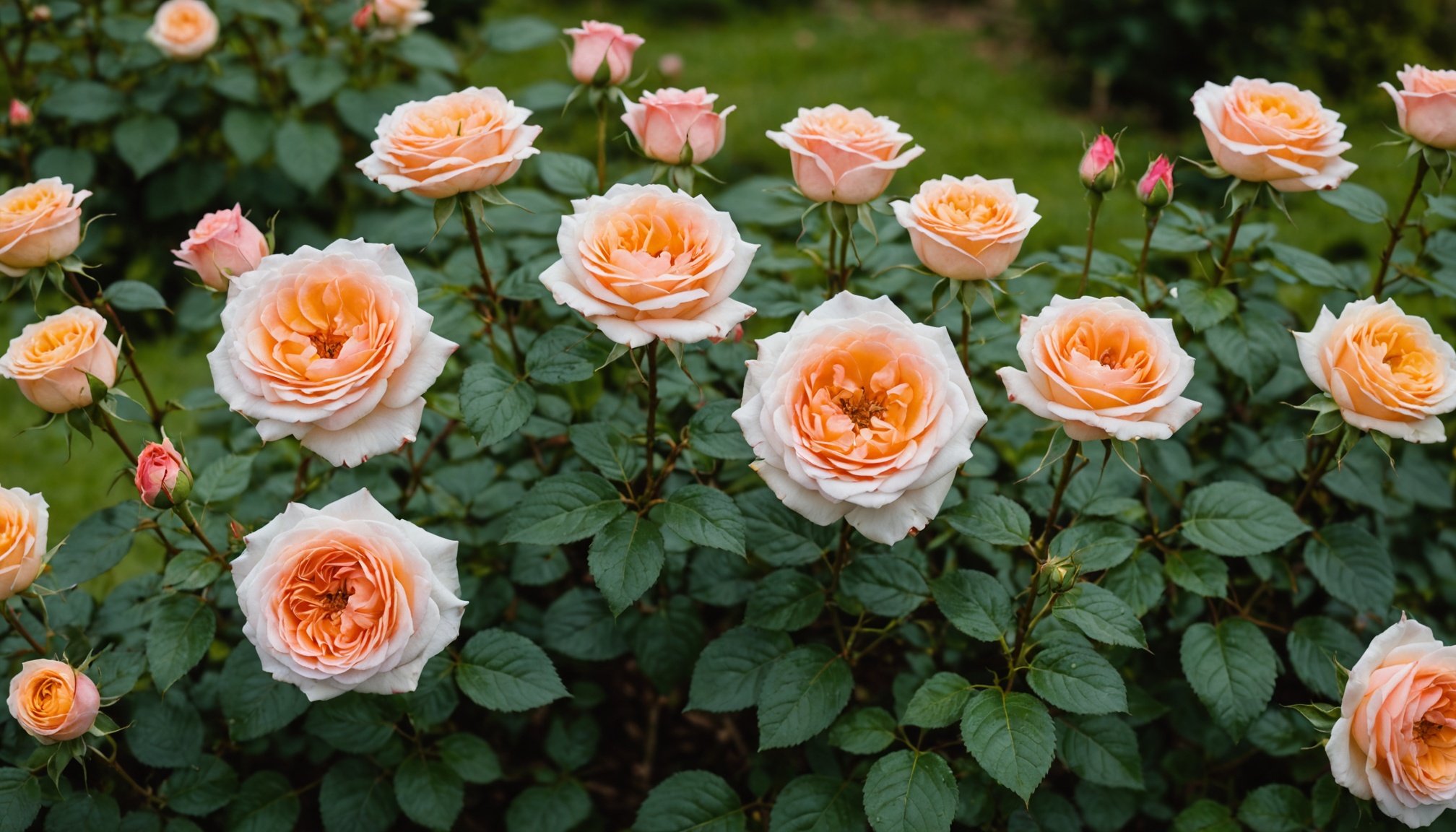Unlocking the Secret: The Perfect Soil pH for Thriving Roses in the UK
When it comes to growing roses in the UK, one of the most critical factors to consider is the soil pH. Roses, whether they are miniature, hybrid teas, or floribundas, have specific soil requirements that, when met, can lead to vibrant blooms and healthy plant growth. Here’s a comprehensive guide to help you understand and achieve the perfect soil pH for your roses.
Understanding Soil pH and Its Importance
Soil pH is a measure of the soil’s acidity or alkalinity, with a pH of 7 being neutral, below 7 being acidic, and above 7 being alkaline. Most garden plants, including roses, thrive in slightly acidic to neutral soil conditions, typically between a pH of 6.0 and 7.0[2][3].
In parallel : Mastering the Art of Propagating Rare UK Native Plants: Effective Techniques for Success
Why pH Matters for Roses
Roses prefer a slightly acidic to neutral soil pH because it allows for optimal nutrient availability. Here’s what happens when the soil pH is off:
- Too Acidic (pH < 6.0): While some roses can tolerate acidic conditions, extremely low pH levels can lead to nutrient deficiencies and poor plant health.
- Too Alkaline (pH > 7.0): Alkaline soils can cause nutrient lockout, where essential nutrients like iron, zinc, and manganese become unavailable to the plant, leading to yellowing leaves and poor growth[1][3].
Identifying Your Soil Type
Before adjusting the soil pH, it’s crucial to identify your soil type. Here are the main soil types found in the UK and their characteristics:
Also read : Top garden trends for 2024: transform your outdoor space
| Soil Type | Characteristics | Best For Growing | UK Regional Notes | Improvement Tips |
|---|---|---|---|---|
| Clay | Heavy, cold, nutrient-rich, sticky when wet, hard when dry | Roses, pears, plums, flowering plants | Common in Midlands | Add organic matter in autumn, avoid digging when wet |
| Sandy | Light, dry, free-draining, warms quickly | Root vegetables, bulbs, Mediterranean herbs | Coastal and eastern regions | Add organic matter regularly, mulch to retain moisture |
| Silt | Smooth, retains moisture, fertile, easily compacted | Irises, hardy geraniums, most vegetables | River valleys and lowlands | Create permanent paths, avoid working when wet |
| Chalky | Alkaline, stony, free-draining, shallow | Lavender, clematis, Mediterranean plants | Southern England | Add organic matter, use specialist fertilizers |
| Peaty | Acidic, high organic matter, water retentive | Rhododendrons, azaleas, heathers | Scotland and Wales | Add lime if needed, improve drainage |
| Loamy | Balanced, fertile, easy to work, good drainage | Most plants, vegetables, fruit trees | Found across the UK | Maintain with annual composting, light cultivation |
Performing a Soil Test
To determine your soil pH and type, you can perform a simple soil test:
- pH Testing: Use a standard pH testing kit or a battery-free pH meter to measure the soil pH. Take samples from about 6 inches deep to get an accurate reading[2][3].
- Texture Test: Perform the squeeze test by moistening a small amount of soil and squeezing it. Observe how it behaves:
- Clay: Forms a tight ball that doesn’t crumble.
- Sandy: Falls apart easily.
- Silt: Forms a loose ball that crumbles slightly.
- Loamy: Forms a loose ball that holds its shape but crumbles easily[2][3].
Adjusting Soil pH for Roses
Once you know your soil type and pH, you can take steps to adjust it if necessary.
Lowering Soil pH
If your soil is too alkaline, you need to lower the pH. Here are some methods:
- Elemental Sulphur: Apply elemental sulphur in the form of small chips around your plants. For example, Sulphur Soil can be scattered at a rate of 56g per square meter twice a year in the spring and autumn. This natural soil acidifier can lower the pH and its effects can last up to two years[1].
- Aluminium Sulfate: This is another effective agent for lowering soil pH, but it acts more quickly than elemental sulphur. However, it should be used with caution as it can be more aggressive[3].
Raising Soil pH
If your soil is too acidic, you need to raise the pH. Here’s how:
- Ground Agricultural Limestone: This is a common and safe way to increase the soil pH. It is especially useful for peaty soils that are highly acidic. Apply the limestone according to the manufacturer’s instructions and the results of your soil test[3].
Improving Soil Structure and Health
In addition to adjusting the pH, improving the overall soil structure and health is crucial for rose growth.
Adding Organic Matter
Organic matter is essential for maintaining soil health. Here are some ways to add it:
- Compost: Annual addition of compost can significantly improve soil fertility and structure. Compost adds nutrients, improves drainage, and supports beneficial microbial activity[2][3].
- Mulch: Mulching around your rose plants helps retain moisture, suppress weeds, and regulate soil temperature. Organic mulches like wood chips or shredded leaves can gradually improve soil structure over time[2][3].
Choosing the Right Compost
For roses, especially those that prefer slightly acidic conditions like hybrid teas and floribundas, using an ericaceous compost can be beneficial. Ericaceous compost is specifically formulated for acid-loving plants and can help maintain the optimal pH range.
Practical Tips for Growing Roses in Different Soil Types
Here are some practical tips tailored to different soil types:
Clay Soil
- Add Organic Matter: Incorporate compost or well-rotted manure to improve drainage and aeration.
- Avoid Digging When Wet: Digging in wet clay soil can damage its structure. Wait until it dries out slightly.
- Choose Robust Plants: Plants like hydrangeas, azaleas, and forsythia thrive in clay soil due to their robust root systems[2][3].
Sandy Soil
- Add Organic Matter Regularly: Sandy soils lack water retention, so adding compost or peat moss can help.
- Mulch to Retain Moisture: Mulching helps retain moisture and reduce soil temperature fluctuations.
- Choose Drought-Tolerant Plants: Plants like Mediterranean herbs and bulbs do well in sandy soils[2][3].
Chalky Soil
- Add Specialist Fertilizers: Chalky soils are alkaline and nutrient-deficient. Use specialist fertilizers designed for alkaline soils.
- Choose Alkaline-Loving Plants: Plants like lavender, clematis, and fruit trees thrive in chalky soils.
- Mulch Heavily: Mulching helps retain moisture and improve soil fertility[2][3].
Case Study: Growing Miniature Roses
Miniature roses are a great example of how understanding and adjusting soil pH can lead to thriving plants.
Soil Requirements
Miniature roses prefer rich, well-drained, and slightly acidic to neutral soil conditions. Here are some key points:
- Soil pH: Neutral to slightly acidic (pH 6.0-7.0).
- Soil Type: Loamy soil is ideal, but if planting in pots, use lightweight potting soil to avoid root rot[4].
Planting and Care
- Planting: Plant miniature roses in the spring using well-drained soil. If planting in pots, fill the pot about 2/3 full of prepared soil mix.
- Watering: Water deeply with about 1 inch of water per week. Aim the hose at the base of the plant to avoid spraying the delicate blooms.
- Fertilizing: Use commercial rose food or general all-purpose fertilizer, applied according to label instructions. Fertilize when the bush first leafs out and after each heavy flush of blooms[4].
Growing thriving roses in the UK is not just about planting them in any soil; it’s about creating an optimal environment that meets their specific needs. By understanding your soil type, adjusting the pH if necessary, and improving soil structure and health through the addition of organic matter, you can ensure your roses bloom vibrantly and remain healthy.
Key Takeaways
- Soil pH: Aim for a slightly acidic to neutral pH (6.0-7.0) for most rose varieties.
- Soil Type: Identify your soil type and adjust accordingly. Loamy soil is generally ideal for roses.
- Organic Matter: Regularly add compost and mulch to improve soil fertility and structure.
- Soil Testing: Perform regular soil tests to monitor pH and nutrient levels.
By following these guidelines and tips, you’ll be well on your way to creating a garden where your roses can flourish, providing you with years of beauty and enjoyment.
Additional Resources
For further guidance, consider the following resources:
- Soil Testing Kits: Invest in a reliable soil testing kit to monitor your soil pH and nutrient levels regularly.
- Gardening Books: There are many excellent books on gardening that provide detailed advice on soil management and rose care.
- Local Gardening Clubs: Joining a local gardening club can connect you with experienced gardeners who can offer valuable advice and tips.
Remember, good soil management is an ongoing process. By working with your soil’s natural properties and making the necessary adjustments, you can create a thriving garden that brings joy and satisfaction to your gardening journey.











